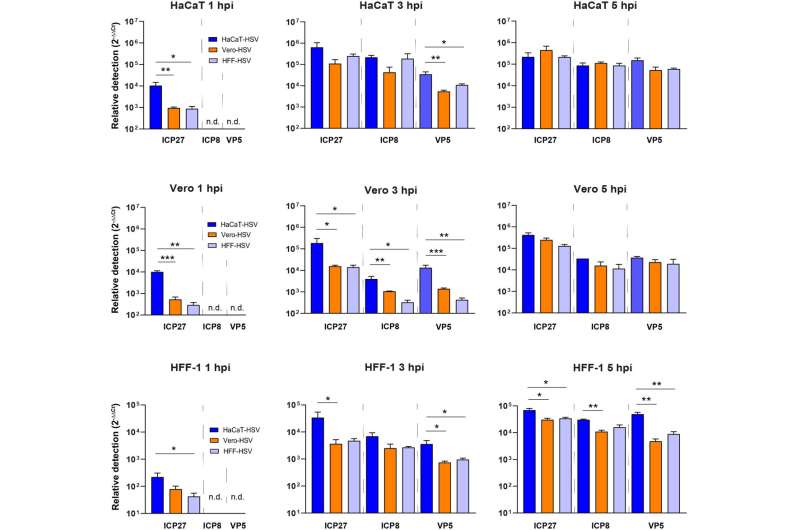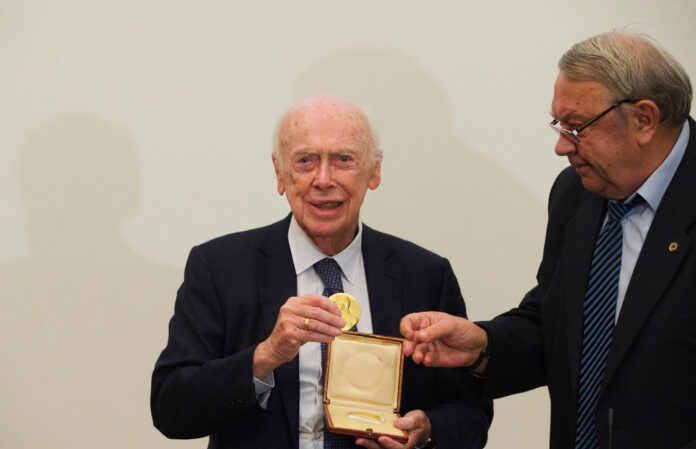Matthew Taylor likened his recently published work alongside doctoral student Gary Dunn to kicking over a rock. Once the discovery was made, it was time to see what lay beneath.
Taylor, an associate professor in Montana State University’s Department of Microbiology and Cell Biology, has studied the replication and infection mechanisms of herpes viruses for more than a decade. Dunn, now a postdoctoral researcher at the University of Idaho, was in the midst of his doctoral work in Taylor’s lab when he realized something: Herpes viruses cultivated using one kind of host cell—known as a producer cell—exhibited differences from the same virus cultivated with a different producer cell.
It was a seemingly small discrepancy with potentially potent ripple effects: How might those differences affect a virus’s ability to infect its host, or its susceptibility to treatment? Scientists have used a variety of established cell lines—producer cells that allow for easily repeatable experiments—for decades, so Dunn and Taylor were examining the very foundation of the field.
“This project is very fundamental virology. It speaks to many of the things we had to do at the very beginning,” said Taylor. “We wanted a propagated virus, so in the 1950s scientists grabbed a cell line which was effective. We have 70 years of development now, and I think as a modern virologist, we constantly need to ask, are these the right ways?”
Herpes viruses are hugely common all over the world, causing everything from cold sores and chicken pox to shingles and genital herpes. It is estimated that roughly 70% of the world’s population carries herpes simplex virus 1 (HSV-1). For many, the virus causes mild symptoms that resolve quickly, but for some, HSV-1 can lead to severe and lasting effects, including encephalitis (inflammation of the brain).
While the work examining producer cells is fundamental, it challenges historical paradigms of how virologists have conducted research. The findings from Dunn’s doctoral research exploring the impact of different types of producer cells on the resulting cultivated viruses is published in the Journal of Virology in an article titled “The producer cell type of HSV-1 alters the proteomic contents and infectious capacity of virions.”
When scientists study viruses, they first grow the virus by infecting producer cells in a lab setting. This gives the virus a host that it uses to replicate itself, allowing researchers to observe that process and the mechanisms viruses use to infect their hosts.

There are many producer cell lines that scientists use based on the goals of their research, Taylor said, most of which were cultivated several decades ago. Those different lines allow scientists to study how viruses replicate on everything from lung cells to kidney cells and even in blood cells.
Dunn’s work is some of the first to establish that different producer cells lead to differences in the resulting viruses. He noticed that some cultivated viruses had different protein compositions and activated different genes during the replication process. Even slight differences, he said, could have downstream impacts on how viruses establish infection and respond to medical intervention.
“Clinically, if you understand that the cell type that’s being used to produce a virus can change its composition and other interactions that are taking place, you can start targeting different components of the virus that might be more relevant,” Dunn said. “If you’re talking about a virus derived from one cell type that’s causing differences in protein composition, maybe you could inhibit those interactions, which could lead to new options in treatment.”
Continuing to explore the differences among viruses cultivated with various cell lines could also guide studies into how viruses move through different parts of the body. A virus may replicate differently in a lung than it does in a kidney, and that may also influence how it is spread from person to person.
“The viral genome encodes its own proteins to duplicate itself, but there’s a lot more to it than that,” Dunn said. “It takes up cellular components of its host as well, and that incorporation of cellular components into viruses is more of a recent point of emphasis in virology. You have hundreds of different cell types in your body, not to mention all the cell types available for research. You could really make a career out of this kind of research.”
Understanding and cataloging the differences that emerge when different types of producer cells are used will guide future research in Taylor’s lab. Now that the rock has been kicked over, it’s time to explore what’s underneath. Scientists in the 1950s used the best cell lines they knew, and Taylor hopes today’s scientists can do better research based on better knowledge.
“That’s part of the scientific principle. You do the best experiments you can at the time, and when new experiments come along, and the data comes along, we need to be open to those ideas,” he said. “Science is a living thing, and this work is a great example of that.”
More information:
Gary Dunn et al, The producer cell type of HSV-1 alters the proteomic contents and infectious capacity of virions, Journal of Virology (2025). DOI: 10.1128/jvi.00829-25
Montana State University
Citation:
Herpes viruses cultivated from different cell lines display distinct biological properties, research reveals (2025, October 2)
retrieved 3 October 2025
from https://medicalxpress.com/news/2025-10-herpes-viruses-cultivated-cell-lines.html
This document is subject to copyright. Apart from any fair dealing for the purpose of private study or research, no
part may be reproduced without the written permission. The content is provided for information purposes only.


